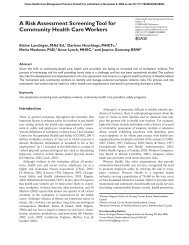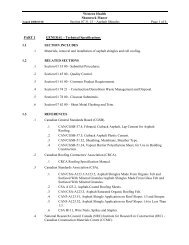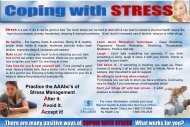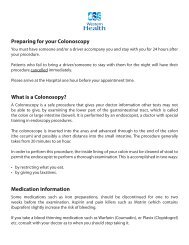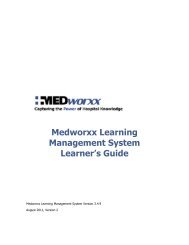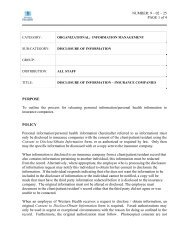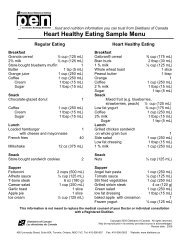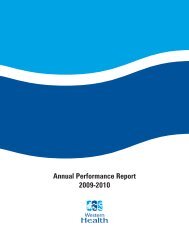Create successful ePaper yourself
Turn your PDF publications into a flip-book with our unique Google optimized e-Paper software.
What is <strong>Body</strong> <strong>Image</strong>?• How you see yourself whenyou look in the mirror.• How you picture yourselfin your mind.• How you think your body looksto others.
Positive <strong>Body</strong> <strong>Image</strong> is:• Accepting your body the way it is.• Appreciating your shape, size and otherphysical characteristics.• Remembering that how you look doesn’t definethe person you are.• Feeling comfortable with who you are.
Negative <strong>Body</strong> <strong>Image</strong> is:• Not accepting your body the way it is.• Feeling ashamed or selfconsciousabout the wayyou look.• Being overly self criticaland comparing yourselfto others.<strong>Body</strong> image affects your self esteem.
Barbie
If Barbie was real:• Her back would be too weak to support herupper body.• Her body would be too narrow to contain morethan half of her liver and a few centimeters ofbowel.• She would die from malnutrition.
Facts:• Everyone is different.• Different cultures have different ideas of what isattractive and beautiful.• The perception of an ideal body type haschanged over time.
1940’s Marilyn Monroe
1950’s Betty Paige
1960’s Twiggy
1990’s Kate Moss
Facts:• More than 80% of high school girls try tochange their weight.• Over 50% of girls who see themselves as the“right” weight still try to lose weight.• 40% of adolescent boys are dissatisfied withtheir bodies.• Girls as young as 5 and 6 are engaging inweight control measures.• An estimated 450,000 women suffer fromeating disorders in Canada.
An eating disorder is:• When a person eats, or avoids eating, in amanner which negatively affects both one'sphysical and mental health.A person can be any size andhave an eating disorder.
Eating disorder occurs when:• A person is constantly thinking about eatingor not eating.• Feels out of control around food.• Uses food to meet needs other than hunger.• Becomes obsessed with food, weight, andbody shape.
Eating Disorders: Facts• 35 - 75% of women with serious eating andweight problems have experienced abuse.• More are likely to develop drug or alcoholaddictions.• May suffer from depression.• Most eating disorders begin in the teenageyears.
Risks for developing aneating disorder:• Having unrealistic expectations of yourself.• Low self esteem and poor body image.• Personal and family conflict.• A family member with an eating disorder.
Most Common Eating Disorders:• Anorexia Nervosa• Bulimia Nervosa
Anorexia Nervosa:• A psychological disorderwhere a person is obsessedwith being thin.• Extremely low body weight and body imagedistortion.• Obsessive fear of gaining weight.
Symptoms:• Severe weight loss• Excessive exercising• Refusing food in fear of gaining weight• Increased growth of facial hair• Feeling cold all the time• Irregular or absent period (amenorrhea)• Dry, yellow skin
Bulimia Nervosa:• A psychological disorder• Recurrent binge eating followed bycompensatory behaviors:- Self induced vomiting (purging)- Fasting- Laxatives- Over exercising
Symptoms:• Preoccupied with food• Distorted perception of body weight and size• Frequent dieting• Abuse of laxatives, diet pills and diuretics• Compulsive exercising• Vomiting after eating• Irregular periods• Heart damage• DepressionMay not have any weight loss.
Eating Disorders:• Are very serious conditions.• Don’t go away on their own.• People with eating disorders require treatmentto manage their conditions.• In extreme cases can cause death.
Eating Disorders:If you or someone you know has an eatingdisorder, talk to someone you trust.• Teacher• Guidance Counselor• Public <strong>Health</strong> Nurse• Parents• Family Doctor
How to improve yourself esteem:• Feel good about who you are.• Focus on the positive.• Make realistic goals and workon achieving them.• Do things you enjoy.• Accept compliments whenyou receive them.• Believe in yourself.• Have faith in your abilities.• Be proud of past successes.
Summary:• A healthy body image is important for a healthyself esteem.• Everyone is different.• “Ideal” body types change over time.• Anorexia nervosa and bulimia nervosa areserious eating disorders.If you or someone you know has an eatingdisorder, talk to someone you trust.



